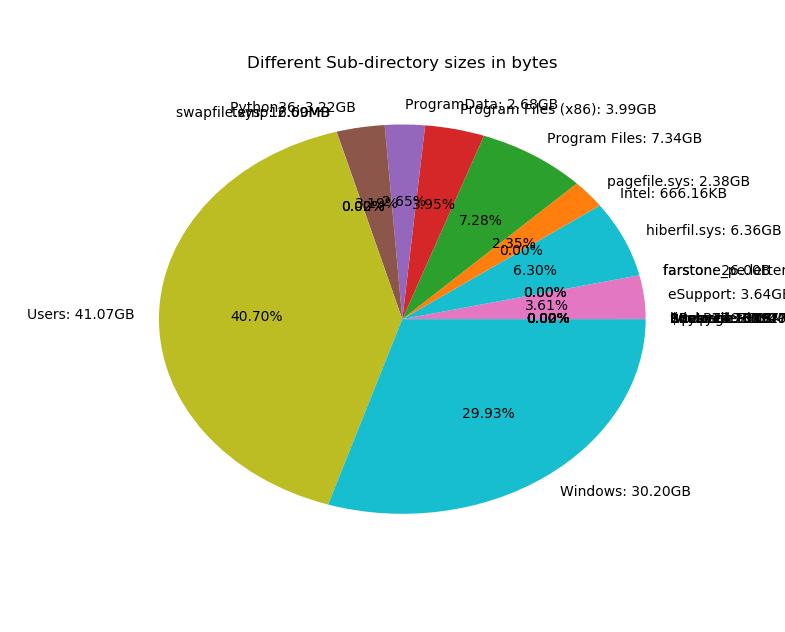Python如何获取目录的大小?在 Python 中以字节为单位计算目录的大小,并使用 matplotlib 绘制饼图以查看哪个子目录的大小最大。
你有没有想过如何使用 Python 以字节为单位获取文件夹大小?你可能已经知道,os.path.get_size()函数只返回正确文件的正确大小,而不是文件夹。在本快速教程中,你将学习如何在 Python 中创建一个简单的函数来计算目录的总大小。
让我们开始吧,打开一个新的 Python 文件:
import os下面的核心函数根据目录的相对或绝对路径计算目录的总大小:
def get_directory_size(directory):
"""Returns the `directory` size in bytes."""
total = 0
try:
# print("[+] Getting the size of", directory)
for entry in os.scandir(directory):
if entry.is_file():
# if it's a file, use stat() function
total += entry.stat().st_size
elif entry.is_dir():
# if it's a directory, recursively call this function
total += get_directory_size(entry.path)
except NotADirectoryError:
# if `directory` isn't a directory, get the file size then
return os.path.getsize(directory)
except PermissionError:
# if for whatever reason we can't open the folder, return 0
return 0
return total在以上的Python获取目录的大小示例中,请注意,我使用了os.scandir()函数,该函数返回给定目录中条目(文件或目录)的迭代器。
如果给定的路径不是文件夹(文件或链接),os.scandir()会引发NotADirectoryError,这就是我们捕获该异常并仅返回该文件的实际大小的原因。
如果它无法打开文件(例如系统文件),它也会引发PermissionError,在这种情况下,我们将只返回0。
如何在Python中获取目录的大小?上面的函数将返回以字节为单位的大小,这对于大目录当然是不可读的,因此,让我们创建一个函数来将这些字节缩放为 Kilo、Mega、Giga 等:
def get_size_format(b, factor=1024, suffix="B"):
"""
Scale bytes to its proper byte format
e.g:
1253656 => '1.20MB'
1253656678 => '1.17GB'
"""
for unit in ["", "K", "M", "G", "T", "P", "E", "Z"]:
if b < factor:
return f"{b:.2f}{unit}{suffix}"
b /= factor
return f"{b:.2f}Y{suffix}"好的,我要在我的 C 盘上测试这个(我知道它很大):
get_size_format(get_directory_size("C:\\"))这花了大约一分钟并返回以下内容:
'100.91GB'Python获取目录的大小示例 - 现在,如果我想知道哪些子目录占用了大部分空间怎么办?好吧,下面的代码不只是计算每个子目录的大小,而是使用matplotlib库(你可以在其中安装使用pip3 install matplotlib)绘制一个饼图,显示每个子目录的大小:
import matplotlib.pyplot as plt
def plot_pie(sizes, names):
"""Plots a pie where `sizes` is the wedge sizes and `names` """
plt.pie(sizes, labels=names, autopct=lambda pct: f"{pct:.2f}%")
plt.title("Different Sub-directory sizes in bytes")
plt.show()
if __name__ == "__main__":
import sys
folder_path = sys.argv[1]
directory_sizes = []
names = []
# iterate over all the directories inside this path
for directory in os.listdir(folder_path):
directory = os.path.join(folder_path, directory)
# get the size of this directory (folder)
directory_size = get_directory_size(directory)
if directory_size == 0:
continue
directory_sizes.append(directory_size)
names.append(os.path.basename(directory) + ": " + get_size_format(directory_size))
print("[+] Total directory size:", get_size_format(sum(directory_sizes)))
plot_pie(directory_sizes, names)现在,这将目录作为命令行中的参数:
python get_directory_size.py C:\Python如何获取目录的大小?下面是结果,这将显示一个漂亮的馅饼,看起来像这样:

如何在Python中获取目录的大小?好的,这是本教程的内容,如果你想了解有关在 Python 中处理文件和目录的更多信息,请查看本教程。

